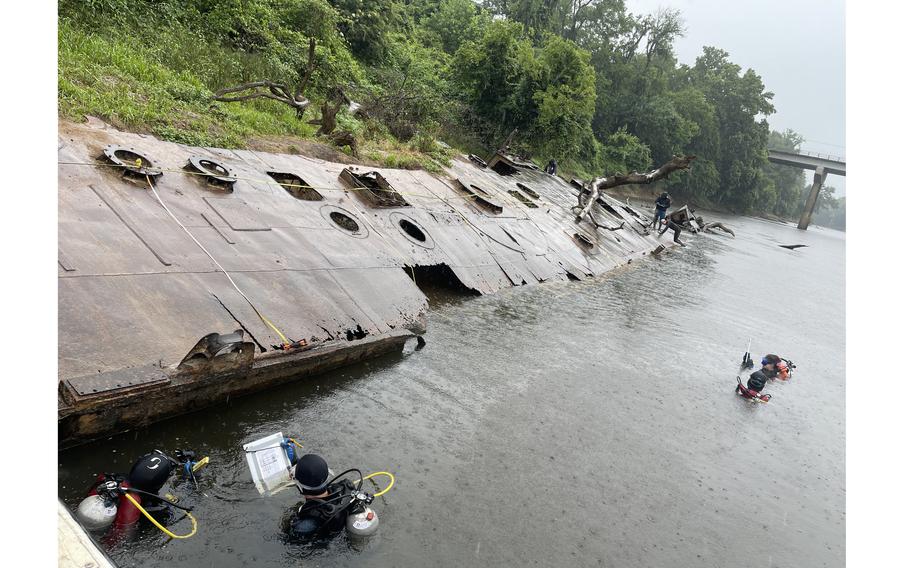
Archaeologists record the starboard side of the remaining structure of PC-1084. (Nathan Richards, East Carolina University Program in Maritime Studies)
(Tribune News Service) — One of the last known subchasers built to defend the U.S. in World War II has spent the past 80 years sitting in North Carolina’s Cape Fear River, and historians aren’t exactly sure why it’s still there.
Like so many bits of WWII weaponry, the USS Patrol Craft-1084 was sold off after the war, putting it in the hands of an entrepreneur with big ideas for its future, historians say.
Clearly, intentions changed, creating something of a mystery.
The PC-1084 is now state property and East Carolina University has decided it’s time for an “archaeological biography” to solve the many mysteries surrounding how a warship traveled more than 100 miles inland just to die a slow death in river mud.
How did it end up here?
The ugly truth about PC-1084 is that it went from trying to sink German subs to being sold for an estimated cost of $5 a ton.
“I’ve seen ships become bridges, swimming pools, grain silos, wharves and jetties. In the literature, we also know they became warehouses, jails, houses, taverns, banks and brothels after being run ashore. Sometimes floating, sometimes not,” according to Nathan Richards, a professor in the Program in Maritime Studies at East Carolina University’s Department of History.
“People in the past were very creative with reuse. They did not live in today’s ‘throwaway’ consumer culture.”
In the case of PC-1084, the intention was to use it as a floating dock near the Grove Street bridge in Fayetteville, records indicate.
Unsubstantiated reports say businessman Richard Minges — a Pepsi Cola bottler in the Fayetteville area — purchased the vessel in 1947 for around $2,250, which is about $32,000 in 2025, Richards said.
It’s believed the subchaser was towed to Fayetteville, which explains why there is no record of Minges ever registering the PC-1084 as a vessel, Richards said.
“The same sources (uncorroborated) then say it was sold to Oscar Breece and his brother to be used at the site that became known as Breece’s landing (the current site). Breece owned the nearby dance hall,” Richards said. “Breece used PC-1084 to tie up his pleasure yacht Florida.”
Yet, researchers have yet to find evidence of Breece owning a pleasure yacht named the Florida, Richards said.
The lack of hard facts is what prompted ECU graduate student Harley Drange to take on the investigation as a thesis project. It could take him a year or longer to sort fact from folklore, Richards said.
Not-so-glorious past
PC-1084 was among 973 patrol boats built to chase submarines during WWII, some of which were sent to allied navies, according to Naval Marine Archive.
“At least 40 were reported as lost in action, but this does not include all the boats that were damaged and abandoned, scuttled or otherwise destroyed,” the archive reports. “Almost all the rest were turned over to either the U.S. Maritime Commission (now MARAD) or the Department of State’s Foreign Liquidation Commission (FLC) for disposal and little is known of what happened to them.”
The PC-1084 was commissioned in August 1943, according to Uboat.net, and little of its wartime activities is known. It’s suspected the boat spent much of the war on escort duty for convoys and submarines, records show.
“It is an important wartime artifact. ... I would say very few of these vessels likely exist anymore,” Richards said.
“So much American WW2 heritage is threatened because these craft were built as fast as possible with the intent of them being ‘disposable’ in a sense (with) no real intended purpose for most craft once the war was over. Flimsy steel did the job of beating the Axis powers, but in the present day (this) means these cultural resources are much more fragile than you’d expect.”
A ship fading fast
Parts of the PC-1084 have gone missing, and it’s suspected the boat was illegally salvaged for scrap metal.
It remains unclear when the ship was officially “abandoned.”
“Unlike a shipwreck, which has a fate that is often pin-pointed to a specific hour or minute of a day, these sort of craft often ‘fade away.’ A ship like this could have been in a sort of mothballed state – tied up with the intention of future use – but the future use just never eventuated and it sank,” Richards said.
A general statute in North Carolina notes all shipwrecks and underwater archaeological artifacts that have been unclaimed for more than 10 years count as “implied abandonment.”
“I think it is rapidly deteriorating. While we were there, we saw a flooding event that moved a tree that had fallen on the ship. A bulkhead collapsed, some decking subsided, and some steel plating on the starboard side folded back like it was a can of food,” Richards said.
“It will likely continue to collapse, with perhaps parts of the hull sliding into the Cape Fear River.”
©2025 Raleigh News & Observer.
Visit newsobserver.com.
Distributed by Tribune Content Agency, LLC.